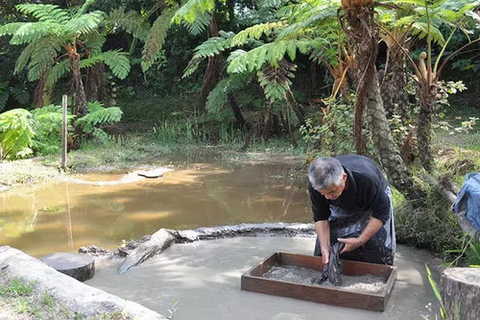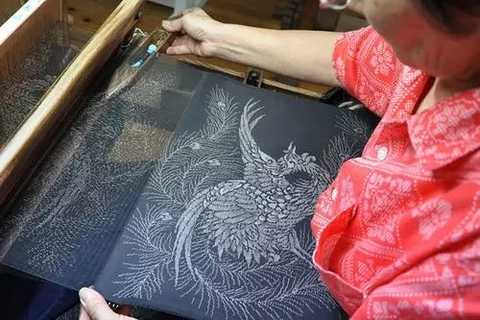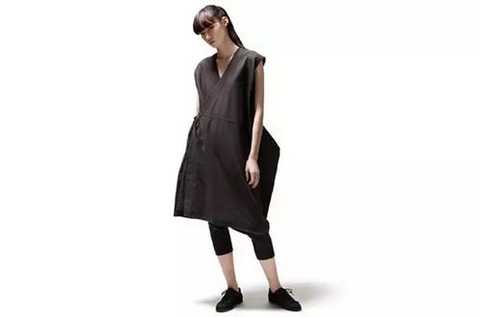Between the white sand beaches and lush forests of Amami Island in Kagoshima, southern Japan, a unique Japanese high-end fabric is produced: Oshima. Oshima is a kind of crepe that has long been considered one of the most advanced kimono fabrics. However, due to the continuous decline in demand for kimonos in modern Japan, the production of Oshima is also decreasing. At present, the Japanese government is working with manufacturers and fashion brands to ensure that this unique fabric remains in the world. Oshima’s production has a history of more than 1,300 years, but recently unearthed tools show that the license dates back to earlier. Many factors in the production process of Oshima have led to the uniqueness of this fabric. Generally speaking, the production process of this fabric is divided into 30 separate parts. The main processes include machine, wheel dye, mud dyeing and dyeing. And hand-woven. The raw materials of Oshima are white silk. This white silk was originally produced on the island, but most of it is now imported from Brazil. In order to make a strong black thread, first soak it in the rust stain mixed with the rhizome of tannin and wheel plum (because of the hard texture, this tree is also called iron tree in Japan) for the first time. color. The next step is mud dyeing. The skilled craftsmen, regardless of the spring, summer, autumn and winter, constantly immerse the silk thread in the mud. The large iron-rich soil of the Amami Island will produce a natural chemical reaction with the vegetable dyes on the silk thread, turning the color of the silk into a deep chestnut brown. After five times of mud dyeing, the thread will turn black. But today, chemical dyes are unable to present this special black formed by natural ingredients: pure and warm, soft and shiny. Katsuya Taira, a craftsman who has been making Oshima for more than 30 years, said that he had four hours a day, bending over the mud to dye the silk. During this time, he could dye the 125-mile silk and weave it into one. Rolls require more than 1,250 miles of silk. “Every two weeks, we change the place to wash the water, because after a while, the iron in the land will be exhausted. This is a physical work, but as long as I have the strength, I want to continue. †If the dyed solid black thread is an intensive labor, then the following is the most striking part of the entire production process. In order to make a typical Oshima geometric pattern and pattern, some of the threads are woven with the cotton before dyeing. After dyeing, the cotton thread is removed to give a streak effect. These patterns will eventually appear on the island of Oshima in the form of paintings. These threads will spread over the grid with different color points to form an image. This process was originally done manually and is currently the only computerized part of the entire production process. The grid is used to decide where to thread the cotton into the thread, even in the process of blackening, these parts are still white. After removing a particular portion of the cotton thread at the same time, the craftsman uses a knife-like tongue depressor to weave the threads of other colors. The more colors the pattern, the more times the cotton thread is drawn. This process is the most important part of the entire complex production – as long as you make a mistake, you can't weave it into a fabric. The entire dyeing process of the thread is about 6 to 10 months. After the dyeing is completed, the yarn can be started by placing the thread on the hand loom. This is the first step in making the pattern appear, but when the thread extends over the loom, the pattern is no longer consistent, so the textile worker must constantly re-adjust the thread to match each point on the grid pattern. Each weaver can weave 12-inch fabric a day, and it takes two months to weave a 40-foot roll. KatsuraTaira said: "The most unique thing about Oshima is that, until the final completion, no one knows whether every part of the entire production process can be successfully completed. This is where the job attracts me." The exquisite details of the finished Oshima can not be fully realized through the pictures. Tokuharu Koshima, president of OshimaTsumugi Mura, said: "(Oshima 紬) will not be very soft, nor will it be very hard, not too thick or too thin, because of the dense weaving, even It is very light or warm, and it is not easy to wrinkle.†Oshima Daimura is a production plant established by the father of Yuet Deqing and currently provides sightseeing tours. Like many traditional Japanese handicrafts, Oshima’s production is limited to one place, and production has been declining in recent years. According to Oshima's fabric association data, Oshima arrived at the peak of production in 1976, with an annual output of 11.64 million meters, but today's output is only 360,000 meters. Therefore, the Japanese government is constantly exploring other uses of this fabric outside of kimono. In 2015, KubotaOrimono, a company that manufactures and sells Oshima in Kagoshima, cooperated with clothing manufacturers in Tokyo to create a new brand, tatsugo, which sells ties and bags made by Oshima. Accessories. Recently, Isetan Department Store in Shinjuku, Tokyo hosted an exhibition to showcase Oshima's single items designed by some of Japan's leading fashion brands. These include the skirts of Yohji Yamamoto (pictured below), the jackets of Needles, the shirts and tops of Sasquatchfabrix. Sasquatchfabrix's Daisuke Yokohama said: "Because this is my first time using Oshima, I decided to go to the production plant. The warp and weft yarns are weaved together to make patterns, each thread is designed separately, and the mud is designed according to the specific pattern. Dye and then hand weave." Some brands have used Oshima in this event. Needles's Kiizo Shimizu said he used a muddy black in the spring and autumn 2016 collections and a limited edition slipper with purple dyed fabrics, but this event is the first time in the Big Island.紬Used for clothing. “In order to demonstrate the advantages of this fabric, two coats were made this time. I believe I can show the magnificence of the fabric, but the design is limited due to insufficient fabric.†The narrow width of the cloth is a typical feature of kimono fabrics. Yokoyama Yosuke also said that this will limit the use of Oshima in modern fashion design. Another factor is the high price caused by labor costs and long production times. However, Kyoko Masahiro, who studied design in Paris, said that he would not let Oshima become history. “I want to use Oshima in new ways and on new things. The key is to keep thinking about new ideas.†Lounge Socks,Super Soft Lounge Socks,Warm Lounge Socks,Women Chunky Lounge Socks Jingjiang Pingdong Import&Export Co.,Ltd , https://www.jingjiangsocks.com


July 14, 2024